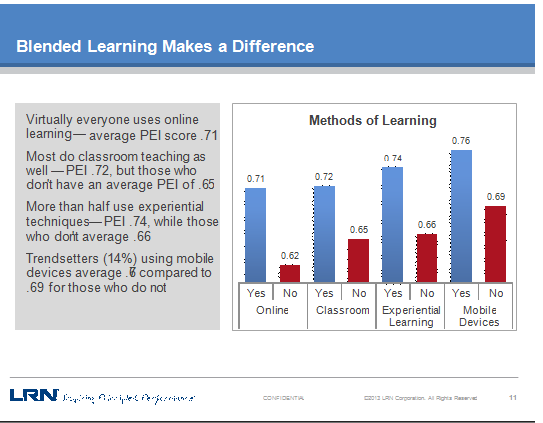
 Education and communication vehicles are cornerstones in the transformation of global workforce culture. Advancing ethical corporate cultures starts with designing effective education programs that promote awareness, impart knowledge, and breed an organizational sense of ownership and responsibility around business conduct.
Education and communication vehicles are cornerstones in the transformation of global workforce culture. Advancing ethical corporate cultures starts with designing effective education programs that promote awareness, impart knowledge, and breed an organizational sense of ownership and responsibility around business conduct.
With today’s business paradigm requiring the integration of legal compliance and ethical behavior, leaders are finding the need to shift their learning strategies to adapt to the new business drivers and evolving workforce landscape. Designing effective compliance and ethics education programs that reach diverse audiences across multiple time zones, in a progressive and innovative manner, is emerging as the new necessity. LRN’s 2013 Ethics & Compliance Leadership Survey shows convincingly that the most effective programs are delivered in a blended suite of modalities, addressing the various learning styles and attention spans of the evolving workforce
Blended Learning, also known as hybrid learning, is an education strategy that adopts mixed modes of learning tools and resources to create a personalized, more relevant type of learning. The result can lead to a more meaningful educational experience that promotes more localized and targeted learning. This can be especially critical in our largely global environment, where one size does not fit all, and social and cultural norms need to be balanced with policies and guidelines. Over the past five years, ethics and compliance programs have begun to recognize the need to structure an effective and sustainable program strategy. Blended Learning introduces more social collaboration into the curriculum and supports delivering lessons in multiple ways and at varying times to support application and skill building around ethical decision making. LRN’s Program Effectiveness Index (PEI), which is based on data from the 2013 Ethics and Compliance Leadership Survey, indicates that Blended Learning makes a difference.*
*Higher PEI scores indicate a greater impact on employee knowledge retention.

Strategic Opportunities to Enhance Education and Communication
Overcome Online Training Fatigue
Break down the silos and support more interactive learning strategies to re-awaken your workforce! Help shift the mindset of employees from a passive “check the box” participant to owning the learning experience. Blended Learning strategies offer guided practice exercises in simulated environments, such as case-discussion exercises, workshops, peer coaching, and gamification. Promoting a learner-centered curriculum allows the employee to recognize and potentially unlearn defensive thought patterns and behavior routines. The learning will shift from passive participation to greater engagement and more meaningful learning experiences.
Promote Tone from the Middle
Studies have shown that front-line management has the greatest influence on setting the tone of acceptable behavior. A manager’s consistency in action shapes the ethical culture, whereas lack of engagement from managers can breed cynicism and skepticism. A majority of misconduct reports are made to managers, whereas less than four percent are made to ethics hotlines.[1]
Managers can lead and facilitate Blended Learning experiences, driving greater reinforcement and addressing context in a practical manner. “Tone from the middle” supports the importance of the concept of Instructive Modeling, whereby a complex skill is broken down into sub-skills. Tone from the middle also conforms with the research around Social Learning Theory[2], which is the notion that people learn from one another through observation, modeling, and imitation. This theory is a bridge between behaviorist and cognitive learning theories because it centers around knowledge retention and motivation. Essentially, it holds that people form ideas of how new behaviors are performed by watching others model the behavior. Positive modeling from management can provide guidance around not only the rules, but by effective strategies for dealing with different situations.
Foster a Culture of Learning: Refresh & Reinforce
Another important concept in the field of social learning is reciprocal determinism.[3] This theory suggests that an individual’s behavior is caused by his or her environment. So, in the realm of catalyzing ethical cultures and effective programs, it is important to support active social learning where peer-to-peer networks are formed and tone from the top and the middle are recognized.
Key conditions of an environment that promotes social learning are:
- awarenessretention (remembering what you became aware of)
- reproduction (being able to reproduce the action or behavior)
- motivation (holding the incentive or emotional response to desire to replicate the behavior)
By adopting a Blended Learning strategy, the ethics and compliance program becomes rich with varied learning activities over a spectrum of time, promoting consistent learning environments that promote awareness, application, skill building, and feedback.
Keeping It Relevant: Targeting Specific Risk
Promoting more learner-centered education can help target specific risk-based education in the right hands at the right time. Front-line management can extend this training by translating the risk-based focus into real-world situations to which their teams can relate.
Promoting Social Learning and Emotional Connections
Ethics and compliance education and communications must address the major risk areas that your assessment process surfaces. Maintaining your organization’s risk profile is a prerequisite for curriculum planning. Yet it is equally important to balance the risk profile with the principled decision-making skills, such as ethical leadership, speaking up, and other capabilities that catalyze a culture of integrity. Recent behavioral ethics research suggests the need for new approaches to education, namely those that tap into intuition and emotion. Simply imparting information about rules to employees and checking for comprehension no longer will do. A good Blended Learning strategy must incorporate more interactive, engaging activities in which learners work together to solve problems, reflect on real-life situations, and “take ownership” of the learning process.
There are several tools and resources in the marketplace that support Blended Learning program strategies. A combination of these learning formats can support an effective strategy.
E-Learning
E-learning or Web-based compliance courses provide employers with a multi-dimensional educational solution to address the complex challenges of the contemporary enterprise. Today’s market has commoditized content consumption with hundreds of Web-based courses in a variety of lengths and instructional styles. The variety of content should help meet the education requirement for virtually any compliance risk area while providing your employees with an ethical framework and cognitive situational skills to make better, more informed, principled decisions.
Mobile Learning
Mobile courses give employees anytime, anywhere access to a wide range of ethics and compliance knowledge, covering critical risk areas. Using the latest technology and best practices to optimize the display across multiple models and sizes of tablet and smartphone devices, mobile courses can extend your education program to hard-to-reach populations and free your employees to learn 24/7, when and where they choose.
Vignettes
Video vignettes use an engaging mix of humor, lively storytelling, and even popular culture to capture the interest of your employees on a range of ethics and compliance topics. Vignettes are short by nature and can easily be dropped into any stage of your communication or education programs.
Gamified Courses
Gamified learning offers organizations a fresh way to catalyze your learning strategy. Gamified courses promote healthy competition with challenges that can enhance knowledge recall, comprehension, and real-life application through social and collaborative learning.
Live Learning and Experiential Toolkits
Experiential learning toolkits are typically entirely self-contained units and include all the necessary information and materials to start a dialogue around catalyzing culture. They are a great high-impact resource for a tone in the middle program, especially for a strategic global rollout. Experiential toolkits support the delivery of a live or virtual facilitated program that can range from 15 to over 60 minutes in length. Through discussions and exercises, employees get to apply core ethics and compliance concepts “experientially” by simulating real-world scenarios, testing their knowledge and understanding of applicable laws, reinforcing key ethical concepts, and engaging in peer-to-peer feedback.
Five Ways to Create an Effective Blended Education and Communications Strategy
- Frequent and regular contact. Blended strategies are effective because they practice the principles of clarity, repetition (reinforcement), variety, and active engagement. Simply put, you can reach more learners—and get through to them more often—when they are exposed to clear messages multiple times through a number of different channels and immersive, engaging formats.
- Localize messages. The design and content of your learning should fit the local cultural context. Imagine a U.S.-based company rolling out anti-corruption training for employees in India, China, or Uzbekistan. Localization requires not only translation into local languages, but also running the scenarios and graphical depictions through a cultural filter so they convey the right meaning. For example, an owl represents wisdom in the West, but in India, it symbolizes corruption and foolishness. When localized, scenarios present risk in a relatable framework, putting issues in a practical context.
- Explore new avenues for learning by utilizing disruptive learning tools. Be informed, and know which channels and formats currently work best for the various audiences in your communication ecosystem. At the same time, you need to break through the noise and combat training fatigue. Instead of a Code course refresh, consider re-orienting code education around an interactive e-Code. This can include links to games and other learning activities that “pull” employees into the learning process. Leverage social learning through role-playing, or the power of story-telling through engaging scenario discussions. A number of LRN partners have re-invigorated ethics education with humorous videos, film festivals, write-your-own-case exercises, and even art exhibits.
- Build tone in the middle and make ethics learning more relevant and personal. For most employees, their supervisor is the face of the company. The expectations and examples set by managers is by far the most influential factor in shaping an organization’s ethos and culture. For example, at a large global manufacturing firm, leaders begin meetings with a short “values contact” (i.e., a short reflection/sharing on a core value such as safety); this simple practice weaves ethics into the workflow and sets the right tone for business activities and decision making. Another organization, a large global aerospace and defense government contractor, has adopted an annual live experiential program to reinforce living their Global Code of Conduct. Each year, every manager runs a one-hour ethics learning session, which is supported by a toolkit that includes customized scenarios. In short, a good Blended Education and Communications strategy will enlist leaders to serve as “ethics envoys” to their teams, and provide those leaders with the right support and tools.
- Measure impact. Ideally, the approach to measuring impact should be holistic enough to capture how your ethical culture is evolving as a whole, while also focusing on specific issues of concern and high-risk areas. The market offers several good survey tools for conducting a “cultural MRI” of your organization. Culture can be measurable when the analytic instrument is well-designed and focuses on observable behaviors. It is important is to get a baseline and then devise a Blended Learning strategy that can close identified gaps in employee knowledge, attitudes, and behaviors. Do not falsely rely on completion rates and test results. Gauge employee feedback, create a two-way dialogue, and run a follow-up survey that evaluates employee behaviors and organizational impact more broadly. Observe participation rates around various learning channels. For example: Is gaming more popular? Is the Code accessed through mobile devices? Are your managers diving in and facilitating quarterly case discussions? Armed with data on how the needle has been moved in key areas, you can justify your program budget and, more importantly, make the case enterprise-wide for catalyzing culture as a business strategy.
[1] Reporting: Who’s Telling You What You Need to Know, Who Isn’t, and What You Can Do About It, Supplemental Research Brief, 2009 National Business Ethics Survey, pp. 1-2, The Ethics Resource Center, available at http://ethics.org/nbes.
[2] Bandura, A. (1997). Self-efficacy: The exercise of control. New York: W.H. Freeman.
[3] Bandura, A. (1977). Social Learning Theory. New York: General Learning Press.
Published by Conselium Executive Search, the global leader in compliance search.


